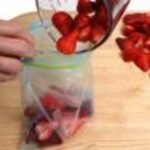As a matter of fact, if you plan your garden well, it’s quite amazing just how much you can produce for the table and freezer in a limited space. In our own case, we have now only an average sized garden, yet we have no trouble filling up a 23-cubicfoot freezer each fall, virtually entirely with our own fruit and vegetables. There are a number of things you can do to make the most of minimal space for a garden patch. I hope these hints will help you to plan your crop.
It’s our family’s opinion that if you grow nothing else, you should grow peas because they’re probably the most satisfying of all garden crops, being a treat that is at the tastiest peak when eaten freshly picked or frozen quickly following harvesting. Traditionally, however, they take up a fair amount of space in the vegetable patch but you can get around this by the very simple expedient of sowing them against the fence, using a netting if it’s a solid type of structure to which the vines would have difficulty clinging. Use netting that you can reach through to pick pods growing on the other side.
Similarly, climbing beans, tomatoes and other vine crops can be grown on a fence or trellis to avoid their sprawling over a limited garden area. This works provided the area is not dense shade. Cucumbers grow well on string strung between two-by-fours which are held horizontal between vertical posts sunk into the ground. Your root vegetables such as carrots, beets and parsnips may be planted in double rows three to four inches apart, resulting in the use of considerably less space than in the case of the conventional single row.
And there’s no need to plant lettuce and radishes all in a row like soldiers being inspected. Scatter your lettuce and radish seed in small blocks or beds, wherever there’s an odd-shaped bit of space that isn’t being used for something else. Around our place, we make early sowings of leaf lettuce and radish in the flower beds so that they are used before the bedding plants are set in their place, providing us with one of those real rewards of gardening, a spring salad fresh from the garden. Some vegetables are most attractive as plants – parsley, for example, or certain varieties of leaf lettuce and even the wispy foliage of carrots – and they can be used for borders or walkways.
Some of our herbs, especially basil, are quite pretty and can enhance a perennial border. Try growing some radish seed in the same row as slow germinators such as carrots and parsnips. This not only saves space, but it marks the rows as well. Not only that, but as you pick the maturing radishes, you automatically thin the slower germinators. Some of the seed catalogs feature selections of vegetable varieties which they especially recommend for gardeners with limited space.
Among them is a favorite standby lettuce, Butter Crunch, renowned for its crispy but tender leaves; the Tiny Tim tomato on a small, compact, bushy plant that is most attractive, and loaded with luscious small fruits all season; the very compact Chinese cabbage which produces heads 18 to 20- inches long tapering from a four-inch base; and the Sugar Baby watermelon which provides an abundance of eight-inch fruits. There is also an acorn squash grown on compact bush-type plants. It is called Table King. Bush pumpkin is also available. For example, the one called Cinderella takes only a space two by three feet per plant.
http://www.umext.maine.edu/yourgarden/planning.htm



